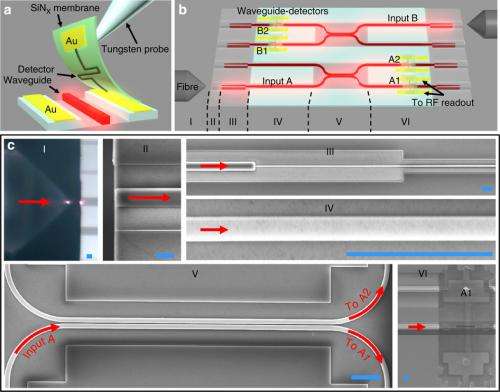January 19, 2015 weblog
Researchers build an array of light detectors on a photonic chip able to record single photons

A large team of researchers with members from MIT, IBM, NASA's JPL and Columbia University has developed a process that that enables scalable integration of superconducting nanowire single-photon detectors (SNSPDs) on a range of photonic circuits. In their paper published in the journal Nature Communications, the team describes their new process and why they believe it may lead one day to a practical photonic quantum processor on a chip.
Scientists have been hard at work trying to build a quantum computer for several years, and while the results have at times been promising, there is still clearly a long way to go. For such a computer to work, a quantum processor of some sort must be created. The current thinking is that such a processor will likely be photon based (because they are relatively easy to entangle and because they can be manipulated easier than other types of quantum bits) and it will have to be chip based. In this new effort, the researchers have created a process that allows for performing scalable integration of SNSPDs on several different kinds of photonic circuits.
For a quantum computer based on photons to work, logic suggests, it will need to be able to detect and process single photons. SNSPDs are thought to be the most promising single photon detectors developed thus far, but, sadly, processes developed for building them have been plagued by a high numbers of defects. In this new effort, the researchers have developed a process that allows for building each detector separately, and putting only those that are defect-free onto an optical chip. The process also calls for building the optical chips separately using standard chip making fabrication techniques.
The team reports that their process allows for building detector arrays that are larger and denser than those built before—and they are more sensitive as well. They proved their claims by building detectors capable of handling 20 percent of photons sent their way—ten times better than previous methods. Each was made on micron-sized membranes and those that passed testing, were transferred to a waveguide using an optical microscope.
The team is continuing their research, now focusing on building larger on-chips systems with more capabilities.
More information: On-chip detection of non-classical light by scalable integration of single-photon detectors, Nature Communications 6, Article number: 5873 DOI: 10.1038/ncomms6873
Abstract
Photonic-integrated circuits have emerged as a scalable platform for complex quantum systems. A central goal is to integrate single-photon detectors to reduce optical losses, latency and wiring complexity associated with off-chip detectors. Superconducting nanowire single-photon detectors (SNSPDs) are particularly attractive because of high detection efficiency, sub-50-ps jitter and nanosecond-scale reset time. However, while single detectors have been incorporated into individual waveguides, the system detection efficiency of multiple SNSPDs in one photonic circuit—required for scalable quantum photonic circuits—has been limited to <0.2%. Here we introduce a micrometer-scale flip-chip process that enables scalable integration of SNSPDs on a range of photonic circuits. Ten low-jitter detectors are integrated on one circuit with 100% device yield. With an average system detection efficiency beyond 10%, and estimated on-chip detection efficiency of 14–52% for four detectors operated simultaneously, we demonstrate, to the best of our knowledge, the first on-chip photon correlation measurements of non-classical light.
via Nanotechweb
Journal information: Nature Communications
© 2015 Phys.org




















